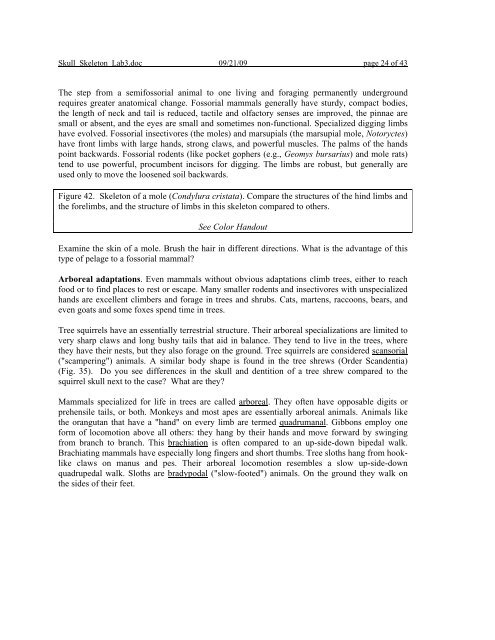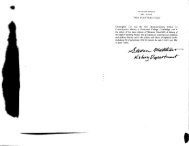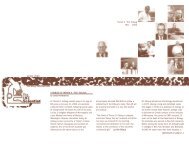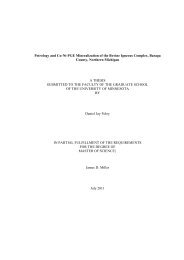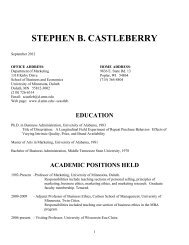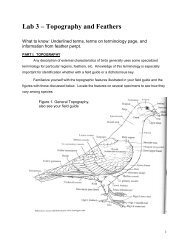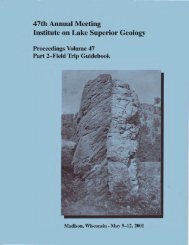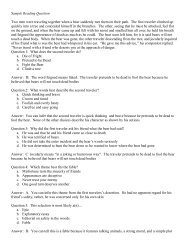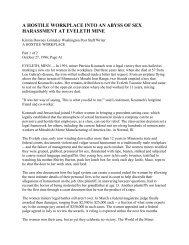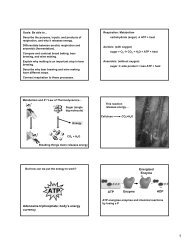POSTCRANIAL SKELETON AND LOCOMOTOR ADAPTATIONS ...
POSTCRANIAL SKELETON AND LOCOMOTOR ADAPTATIONS ...
POSTCRANIAL SKELETON AND LOCOMOTOR ADAPTATIONS ...
Create successful ePaper yourself
Turn your PDF publications into a flip-book with our unique Google optimized e-Paper software.
Skull_Skeleton_Lab3.doc 09/21/09 page 24 of 43<br />
The step from a semifossorial animal to one living and foraging permanently underground<br />
requires greater anatomical change. Fossorial mammals generally have sturdy, compact bodies,<br />
the length of neck and tail is reduced, tactile and olfactory senses are improved, the pinnae are<br />
small or absent, and the eyes are small and sometimes non-functional. Specialized digging limbs<br />
have evolved. Fossorial insectivores (the moles) and marsupials (the marsupial mole, Notoryctes)<br />
have front limbs with large hands, strong claws, and powerful muscles. The palms of the hands<br />
point backwards. Fossorial rodents (like pocket gophers (e.g., Geomys bursarius) and mole rats)<br />
tend to use powerful, procumbent incisors for digging. The limbs are robust, but generally are<br />
used only to move the loosened soil backwards.<br />
Figure 42. Skeleton of a mole (Condylura cristata). Compare the structures of the hind limbs and<br />
the forelimbs, and the structure of limbs in this skeleton compared to others.<br />
See Color Handout<br />
Examine the skin of a mole. Brush the hair in different directions. What is the advantage of this<br />
type of pelage to a fossorial mammal?<br />
Arboreal adaptations. Even mammals without obvious adaptations climb trees, either to reach<br />
food or to find places to rest or escape. Many smaller rodents and insectivores with unspecialized<br />
hands are excellent climbers and forage in trees and shrubs. Cats, martens, raccoons, bears, and<br />
even goats and some foxes spend time in trees.<br />
Tree squirrels have an essentially terrestrial structure. Their arboreal specializations are limited to<br />
very sharp claws and long bushy tails that aid in balance. They tend to live in the trees, where<br />
they have their nests, but they also forage on the ground. Tree squirrels are considered scansorial<br />
("scampering") animals. A similar body shape is found in the tree shrews (Order Scandentia)<br />
(Fig. 35). Do you see differences in the skull and dentition of a tree shrew compared to the<br />
squirrel skull next to the case? What are they?<br />
Mammals specialized for life in trees are called arboreal. They often have opposable digits or<br />
prehensile tails, or both. Monkeys and most apes are essentially arboreal animals. Animals like<br />
the orangutan that have a "hand" on every limb are termed quadrumanal. Gibbons employ one<br />
form of locomotion above all others: they hang by their hands and move forward by swinging<br />
from branch to branch. This brachiation is often compared to an up-side-down bipedal walk.<br />
Brachiating mammals have especially long fingers and short thumbs. Tree sloths hang from hooklike<br />
claws on manus and pes. Their arboreal locomotion resembles a slow up-side-down<br />
quadrupedal walk. Sloths are bradypodal ("slow-footed") animals. On the ground they walk on<br />
the sides of their feet.


